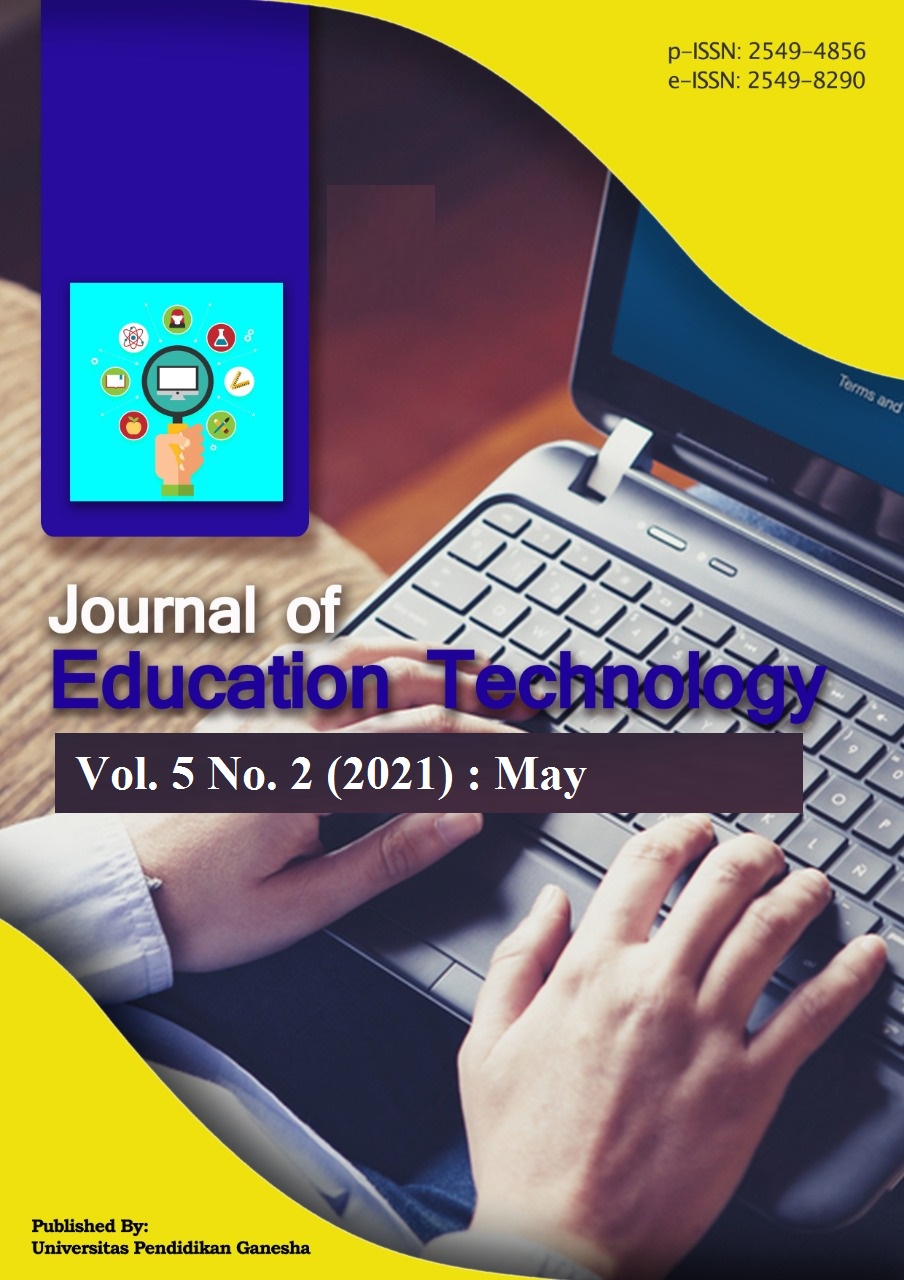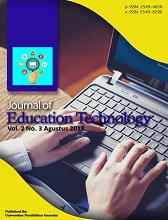The Use of Spices as a Media to Stimulate Children’s Critical Thinking Ability while Study From Home Period
DOI:
https://doi.org/10.23887/jet.v5i2.34984Kata Kunci:
Critical Thinking, SpicesAbstrak
Critical thinking is an essential aspect of the 21st century. There was an outbreak of pandemic covid-19; some educators had difficulty stimulating critical thinking in early childhood. But for some teachers used spice ingredients at home to promote the critical thinking of children. Therefore, this research aimed to provide critical thinking learning solutions during the covid 19 pandemics. This study used a qualitative descriptive method to describe the use of spices in stimulating essential thinking. The data collection technique using interviews, observations and documentation by involving children aged 5-6 years (n= 15). Data collection, data reduction, data display, and conclusion drawing were analyzed by testing data validity using triangulation techniques. This study showed that using spice media in making turmeric herbs acid, making batik from natural dyes, and making dolls through a scientific approach can stimulate critical thinking ability in children in the study from home. So, can be concluded that using spice media stimulate critical thinking ability in children in the study from home.
Referensi
Abidah, A., Hidaayatullaah, H. N., Simamora, R. M., Fehabutar, D., & Mutakinati, L. (2020). The Impact of Covid-19 to Indonesian Education and Its Relation to the Philosophy of “Merdeka Belajar.” Studies in Philosophy of Science and Education, 1(1), 38–49. https://doi.org/10.46627/sipose.v1i1.9.
Abidin, Z. (2016). Penerapan Pemilihan Media Pembelajaran. Edcomtech, 1(1), 9–20.
Afni, N., & Jumahir, J. (2020). Peranan Orang Tua Dalam Meningkatkan Prestasi Belajar Anak. Musawa: Journal for Gender Studies, 12(1), 108–139. https://doi.org/10.24239/msw.v12i1.591.
Asia, chanel news. (2020). “Indonesia’s health system on the brink as coronavirus looms.”
Clark, R. (2019). Assessing the impact of reflective activities in digital and analog electronics courses. IEEE Transactions on Education, 62(2), 141–148. https://doi.org/10.1109/TE.2018.2885720.
Creswell, J. W. (2014). Research Design (Qualitative, Quantitative, and Mixed Methods Approaches). In Society.
Dewayani, T. (2020). Bekerja dari Rumah (Work From Home) Dari Sudut Pandang Unit Kepatuhan Internal.
Dwyer, C. P., Hogan, M. J., & Stewart, I. (2014). An integrated critical thinking framework for the 21st century. Thinking Skills and Creativity, 12, 43–52. https://doi.org/10.1016/j.tsc.2013.12.004.
Dyah Pramesthi, Isyana Ardyati, & Agus Slamet. (2020). Potensi Tumbuhan Rempah dan Bumbu yang Digunakan dalam Masakan Lokal Buton sebagai Sumber Belajar. Biodik, 6(3), 225–232. https://doi.org/10.22437/bio.v6i3.9861.
Fernández-Santín, M., & Feliu-Torruella, M. (2020). Developing critical thinking in early childhood through the philosophy of Reggio Emilia. Thinking Skills and Creativity, 37, 100686. https://doi.org/10.1016/j.tsc.2020.100686.
Harahap, F., Nasution, N. E. A., & Manurung, B. (2019). The Effect of Blended Learning on Student’s Learning Achievement and Science Process Skills in Plant Tissue Culture Course. International Journal of Instruction.
Harnani, S. (2020). Efektivitas Pembelajaran Daring Di Masa Pandemi Covid-19. BDK Kemenag.
Hart, J. L. (2020). Family-Centered Care During the COVID-19 Era. Journal of Pain and Symptom Management, 60(2). https://doi.org/10.1016/j.jpainsymman.2020.04.017.
Haryadi, R. (2021). Pendidikan dalam Bahaya, 25 Anak SMA Nikah karena Wabah. Gatra.com.
Herminastiti, R. (2019). Peran Kegiatan Fun cooking dan Country Project dalam Kemampuan Matematika Awal dan Berpikir Kritis Anak Usia Dini. KINDERGARTEN: Journal of Islamic Early Childhood Education, 2(1), 6. https://doi.org/10.24014/kjiece.v2i1.6993.
Hewi, L., & Asnawati, L. (2020). Strategi Pendidik Anak Usia Dini Era Covid-19 dalam Menumbuhkan Kemampuan Berfikir Logis. Jurnal Obsesi : Jurnal Pendidikan Anak Usia Dini, 5(1), 158. https://doi.org/10.31004/obsesi.v5i1.530.
Hitchcock, D. (2017). Critical Thinking as an Educational Ideal. Argumentation Library, 30(April), 477–497. https://doi.org/10.1007/978-3-319-53562-3_30.
Huang, R. H., Liu, D. J., & Zhan, T. (2020). Guidance on Flexible learning during Campus Closures: ensuring course quality of higher education in COVID-19 outbreak. In Beijing: Smart Learning Institute of Beijing Normal University. researchgate.net.
Husin, S. H., & Yaswinda, Y. (2021). Analisis Pembelajaran Sains Anak Usia Dini di Masa PANDEMI Covid-19. Jurnal Basicedu, 5(2), 581–595. https://doi.org/10.31004/basicedu.v5i2.780.
J.L, S., & Meredith, K. . (2011). Classrom of wonder and wisdom: reading, writing and critical thinking for the 21st century. In Sage Company (p. 23).
Jamiah, Y. (2012). Internalisasi Nilai-nilai Berpikir Kritis Melalui Pengembangan Model Pembelajaran Konsep Matematika Kreatif Pada Pendidikan Anak Usia Dini. Jurnal Pendidikan Dan Pembelajaran (JPP), 19(2), 229–236.
Karma, I., Darma, I. K., & Santiana, I. (2021). Blended Learning is an Educational Innovation and Solution During the COVID-19 Pandemic. International Research Journal of Engineering, IT & Scientific Research.
Kaur, M. (2020). Blended Learning: Need of the Hour. In academiccanvas.highereduhry.com.
Kettler, T. (2014). Critical Thinking Skills Among Elementary School Students. Gifted Child Quarterly, 58(2), 127–136. https://doi.org/10.1177/0016986214522508.
Leicester, M., & Taylor, D. (2010). Critical Thinking Across the curriculum; Developing critical thinking skills, literacy and philosophy in the primary classroom.
Luthfi, E., & Ahsani, F. (2020). Strategi Orang Tua dalam Mengajar dan Mendidik Anak dalam Pembelajaran At The Home Masa Pandemi Covid-19. In Al Athfal : Jurnal Kajian Perkembangan Anak dan Manajemen Pendidikan Usia Dini (Vol. 3, Issue 1). https://ejournal.stainupwr.ac.id/
M. Zainal Arifin, & Agus Setiawan. (2020). Strategi Belajar Dan Mengajar Guru Pada Abad 21 . Indonesian Journal of Instructional Technology, 1(2), 27–46. https://journal.kurasinstitute.com/index.php/ijit/article/view/45.
Miles, M. B., Huberman, A. M., & Saldana, J. (1994). Qualitative Data Analysis : A Methods Sourcebook. Library of Congress Cataloging-in-Publication Data.
Munajim, A., Barnawi, B., & Fikriyah, F. (2020). Pengembangan Kurikulum Pembelajaran di Masa Darurat. DWIJA CENDEKIA: Jurnal Riset Pedagogik, 4(2), 285. https://doi.org/10.20961/jdc.v4i2.45288.
Pantjoro, T. (2020). Potensi Lost Generation Akibat Pandemi Covid-19. YBB.
Pany, P. (2019). Using students’ interest in useful plants to encourage plant vision in the classroom. Plants People Planet, 1(3), 261–270. https://doi.org/10.1002/ppp3.43.
Porter, B. De, & Hernacki, M. (1999). Quantum Learning (S. Meutia (ed.); 5th ed.). Kaifa.
Priyanti, N., & Warmansyah, J. (2021). Improving Critical Thinking Skills of Early Childhood through Inquiry Learning. Jurnal Obsesi : Jurnal Pendidikan Anak Usia Dini, 5(2), 2241–2249. https://doi.org/10.31004/obsesi.v5i2.1168.
Raco. (2010). Metode Penelitian Kualitatif: Jenis, Karakteristik,, dan Keunggulannya. Grasindo.
Rahayu, D. (2020). Students’ E-Learning Experience through a Synchronous Zoom Web Conference System. Journal of ELT Research: The Academic Journal ….
Sugiyono. (2015). Cara Mudah Menyusun Skripsi, Tesis, dan Disertasi (A. Nuryanto (ed.); 3rd ed.). Alfabeta.
Sugiyono. (2016). Metode Penelitian Kuantitatif, Kualitatif Dan R&D (24th ed.). Alfabeta.
Suminah, E., Nugraha, A., Lestari, G. D., Mareta, & Wahyuni, M. (2015). Kurikulum Pendidikan Anak Usia Dini. Apa, Mengapa, dan Bagaimana. Direktorat Pembinaan Pendidikan Anak Usia Dini, 18.
Supriyatna, A., Kinasih, I., Virakawugi Darniwa, A., Jaenudin, M., Sains dan Teknologi, F., Sunan Gunung Djati Bandung, U., & Quran dan Hadist, A. (2020). Evolusi SARS-CoV-2 dalam Perspektif Wahyu Memandu Ilmu (WMI). 1–2.
Teo, P. (2019). Teaching for the 21st century: A case for dialogic pedagogy. In Learning, Culture and Social Interaction (Vol. 21, pp. 170–178). Elsevier Ltd. https://doi.org/10.1016/j.lcsi.2019.03.009.
Triyani, T., Herayanti, L., & Gummah, S. (2019). Effect of Scientific Approach toward Students’ Critical Thinking Skills. Lensa : Jurnal Kependidikan Fisika, 7(1), 15. https://doi.org/10.33394/j-lkf.v7i1.1906
Widyanti, T. (2017). Keterampilan Belajar Abad 21 Untuk Melatih Berpikir Kritis Melalui Sistem Pembelajaran Berbasis Ict. Administrasi Pendidikan : Jurnal Ilmiah Mahasiswa Pascasarjana, 5(2), 143–148. https://jurnal.unigal.ac.id/index.php/adpen/article/view/2031.
Wijaya, E. Y., Sudjimat, D. A., & Nyoto, A. (2016). Transformasi Pendidikan Abad 21 Sebagai Tuntutan. Jurnal Pendidikan, 1, 263–278.
Wulandari, D. R. (2021). Android application innovation as the indonesian basic spices learning media. In Journal of Physics: Conference Series (Vol. 1833, Issue 1). https://doi.org/10.1088/1742-6596/1833/1/012062.
Yamin, M. (2019). Information technologies of 21st century and their impact on the society. International Journal of Information Technology (Singapore), 11(4), 759–766. https://doi.org/10.1007/s41870-019-00355-1.
Yunita, H., Meilanie, S. M., & Fahrurrozi, F. (2019). Meningkatkan Kemampuan Berpikir Kritis melalui Pendekatan Saintifik. Jurnal Obsesi : Jurnal Pendidikan Anak Usia Dini, 3(2), 425. https://doi.org/10.31004/obsesi.v3i2.228.
Yusuf, A. M. (2014). Metode Penelitian Kuantitatif, Kualitatif & Penelitian Gabungan (Suwito (ed.); 1st ed.). Prenadamedia Group.
ŽivkoviĿ, S. (2016). A Model of Critical Thinking as an Important Attribute for Success in the 21st Century. Procedia - Social and Behavioral Sciences, 232, 102–108. https://doi.org/10.1016/j.sbspro.2016.10.034.
Unduhan
Diterbitkan
Cara Mengutip
Terbitan
Bagian
Lisensi
Authors who publish with the Journal of Education Technology agree to the following terms:
- Authors retain copyright and grant the journal the right of first publication with the work simultaneously licensed under a Creative Commons Attribution License (CC BY-SA 4.0) that allows others to share the work with an acknowledgment of the work's authorship and initial publication in this journal.
- Authors are able to enter into separate, additional contractual arrangements for the non-exclusive distribution of the journal's published version of the work (e.g., post it to an institutional repository or publish it in a book), with an acknowledgment of its initial publication in this journal.
- Authors are permitted and encouraged to post their work online (e.g., in institutional repositories or on their website) prior to and during the submission process, as it can lead to productive exchanges, as well as earlier and greater citation of published work. (See The Effect of Open Access)


















